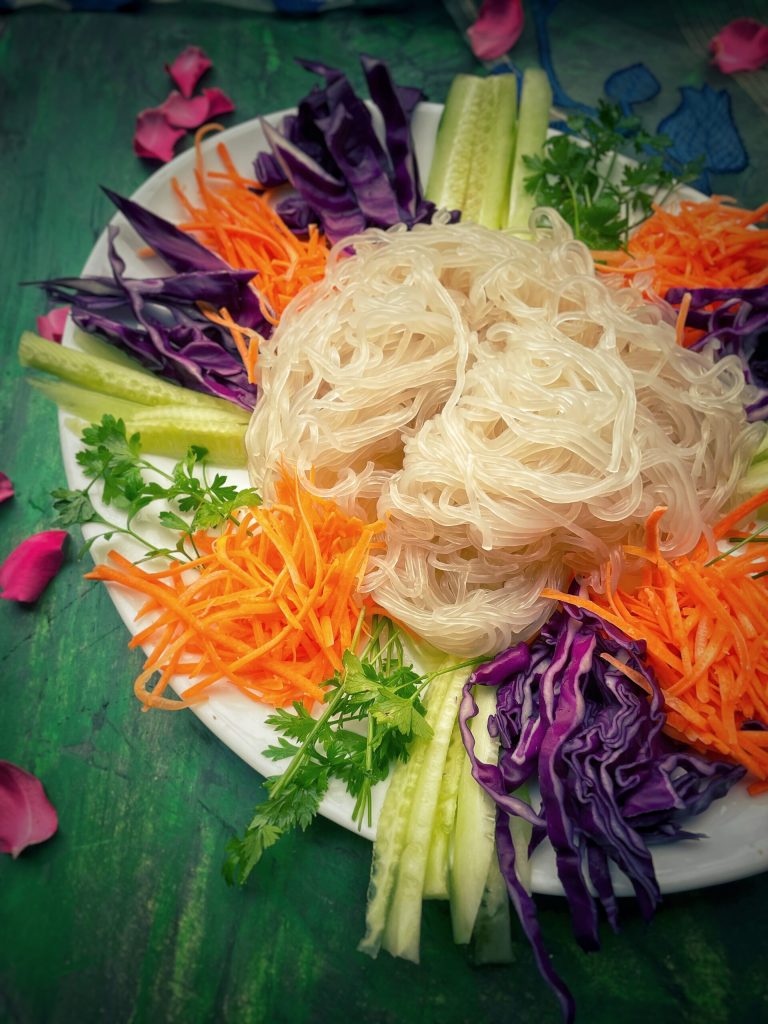The Dà lā pí (大拉皮) is a traditional dish from Northeast Chinese cuisine (Dongbei) known for its wide, transparent noodles made from potato or sweet potato starch (gluten-free), served cold with colorful vegetables and a rich sesame-based sauce.
Some versions of Dà lā pí include strips of stir-fried pork or smoked tofu to add protein to the dish.
Traditionally, the vegetables are arranged decoratively around the noodles, creating a visual contrast between the vibrant colors of the vegetables and the transparency of the noodles.
Dà lā pí is often served as a starter or main course during the summer months, thanks to its freshness and lightness.

- Difficulty: Very easy
- Cost: Cheap
- Preparation time: 10 Minutes
- Portions: 2 People
- Cooking methods: Boiling
- Cuisine: Chinese
- Seasonality: Summer
Ingredients
- 7 oz potato starch noodles
- 2.1 oz Chinese sesame paste (芝麻酱) (or tahini)
- 2 tbsps soy sauce
- 1 tbsp sugar
- 2 tbsps Chinkiang rice vinegar
- 2 tsps sesame oil
- 1 clove garlic
- 1 carrot
- 1/2 cucumber
- to taste red cabbage
- 1 egg
- to taste cilantro
- to taste salt
Steps
Cook the noodles according to the package instructions. If using dried noodles, it’s advisable to soak them first. After cooking, drain and cool them under running water.

Prepare the sauce: In a bowl, mix the sesame paste with 2 tablespoons of warm water until smooth. Add the soy sauce, Chinkiang vinegar, sugar, sesame oil, grated garlic, and salt. Mix well until you have a homogeneous sauce.
Prepare an omelette with the egg.
Assemble the dish: Place the noodles in the center of a serving platter. Surround with julienned vegetables, egg strips, and fresh cilantro.
Serve the sauce on the side.
Mix all the ingredients well before eating, so the sauce coats the noodles and vegetables evenly.
FAQ (Questions and Answers)
What are the noodles used for dà lā pí called?
The noodles used in Da La Pi are called in Chinese:
大拉皮 (dà lā pí) — literally “big pulled noodles”.
They are wide, translucent, and gelatinous, usually made with:
potato starch (土豆淀粉, tǔdòu diànfěn)
or sweet potato starch (红薯淀粉, hóngshǔ diànfěn)
Sometimes they are also called:
宽粉 (kuān fěn) = “wide noodles” (generic term)
or 东北拉皮 (Dōngběi lāpí) = “Northeast pulled noodles”
They should not be confused with 凉皮 (liángpí), which are thinner and made from wheat or rice flour.What other Chinese recipes are made with dà lā pí noodles?
The dà lā pí (大拉皮), or the wide gelatinous noodles from Northeast China, are mostly used in cold or warm preparations.
Here are some traditional Chinese recipes where they are featured:
Liángbàn Lāpí (凉拌拉皮) – Cold Lāpí Salad
One of the most common: the noodles are served cold with a sesame-based sauce, garlic, vinegar, soy sauce, chili oil, julienned cucumber, cilantro, and sometimes slices of pressed tofu or egg.
Chòu Lāpí (臭拉皮) – “Stinky Lāpí”
Typical of some northern areas: similar to the previous one, but with the addition of fermented bean sauce (腐乳) or other fermented ingredients that give a more intense and “funky” flavor.
Ròu Mò Lāpí (肉末拉皮) – Lāpí with minced meat
The noodles are served with stir-fried pork in a thick sauce (based on soy and starch), to be eaten warm.
Kǎo Lāpí (烤拉皮) – Grilled Lāpí
Rare but exists: the lāpí strips are briefly grilled and seasoned with spicy sauces, cilantro, scallion, and aromatic oil.
Lāpí Huǒguō (拉皮火锅) – Hotpot with Lāpí
Added as the final ingredient in spicy or savory broths for hotpot, they absorb flavors well and provide an elastic texture.Are dà lā pí noodles used in Korea?
No, the Chinese dà lā pí (大拉皮) are not traditionally used in Korea.
However, in Korea there are noodles similar in appearance and texture, used in dishes like:
Cheongpomuk (청포묵): mung bean starch jelly, similar to lāpí, used in salad (청포묵무침).
Tangpyeongchae (탕평채): traditional dish with jelly strips (muk), vegetables, meat, and soy sauce.
Dangmyeon (당면): sweet potato noodles, used for example in japchae. However, they are thin and transparent, different from the wide lāpí.

